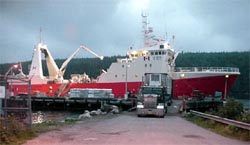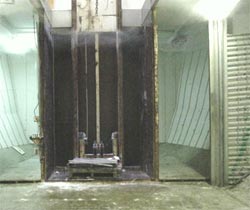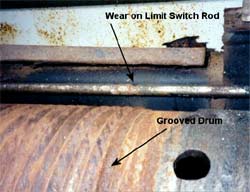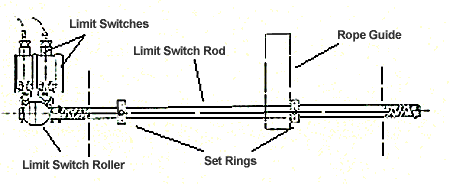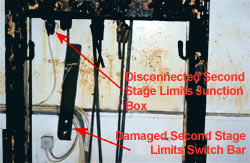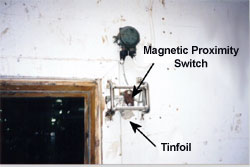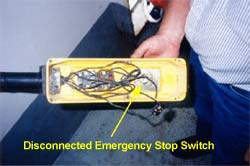Uncontrolled Descent of Freight Elevator
Mersey Venture Freezer Trawler
Mersey Seafood Wharf
Stormont, Nova Scotia
The Transportation Safety Board of Canada (TSB) investigated this occurrence for the purpose of advancing transportation safety. It is not the function of the Board to assign fault or determine civil or criminal liability. This report is not created for use in the context of legal, disciplinary or other proceedings. See Ownership and use of content. Masculine pronouns and position titles may be used to signify all genders to comply with the Canadian Transportation Accident Investigation and Safety Board Act (S.C. 1989, c. 3).
Summary
The fishing vessel Mersey Venture was discharging a cargo of shrimp alongside the wharf in Stormont, Nova Scotia. Two stevedore gangs were working two hatches. The forward hatch is equipped with a freight elevator, which was in use. At approximately 1220 local time, the elevator rope hoist gearbox failed when the platform was at the upper limit of its travel, which caused the drum to freewheel and the platform to descend in a free-fall. Three of the four stevedores on the platform at the time of the failure received injuries consistent with elevator accidents, including shattered heels and broken bones.
Factual information
Particulars of the vessel
| Name | "MERSEY VENTURE" |
|---|---|
| Port of Registry | Liverpool, Nova Scotia |
| Flag | Canada |
| Registry/Licence Number | ON 0809277 |
| Type | Freezer Trawler |
| Gross Tonnage | 2336.96 tons |
| Length | 58.7 mFootnote 1 |
| Built | 1988 - Langsten Slip and Baatbyggeri A/S, Tomrefjord, Norway |
| Propulsion | 3111 brake horsepower |
| Number of Crew | 4 |
| Number of Stevedores | 12 |
| Registered Owner | Mersey Seafoods Ltd. Box 1290, Liverpool, Nova Scotia |
Description of the vessel
Photo 1. F.V. Mersey Venture
The Mersey Venture is a single-screw, conventional stern freezer trawler of all-steel, welded construction. The navigating bridge and crew accommodations are forward of midships. The vessel has a large factory area, located one deck above a large refrigerated hold. There are two hatches, one located forward and the other aft. The forward hatch is equipped with a freight elevator.
The vessel was built to Det Norske Veritas (DNV) Ice Class A. It was imported, and registered in Canada in 1988. Later, the DNV classification was dropped and the vessel became subject to inspection by Transport Canada Marine Safety (TCMS) under the Large Fishing Vessel Inspection Regulations.
Description of the Elevator
Photo 2. Freight Elevator
The elevator was supplied and installed as original equipment at new building by MacGregor-Navire (N) A/S, the marine division of Kone Incorporated. As installed, the elevator consisted of a platform which moved vertically in guides located on a steel structure within a hoistway enclosed on three sides. The device links the factory deck and the refrigerated hold below, with a height of lift of approximately 3.65 metres.
The lift main drive machine (a winding drum type Model No UN2B - 1 electric hoist) is located on top of the steel structure on the forward side. It had two suspension cables of 14 mm diameter steel wire rope rove to advantage through two sheaves configured as single whip purchases. The system had two limit systems to control the vertical travel. The primary stage limit system was located on the rope hoist itself. A secondary stage limit system, using magnetic proximity limit switches, was mounted on the frame of the elevator. The switches provided redundancy in the event of a failure of the primary system. A load cell was installed on the rope hoist to prevent operation of the elevator in an overstressed condition. The safe working load of the elevator was rated at 3.5 tonnes.
Fishing Practices and Operating Environment
The Mersey Venture is one of about a dozen large fishing vessels holding licences, issued under the Northern Shrimp Integrated Management Plan of the Department of Fisheries and Oceans, to fish northern (or pink) shrimp. Most vessels involved are purpose-built for shrimp trawling and range in length from 42.6 m to 74.3 m, with hold capacities from 400 m³ to 1960 m³. Fishing trips generally last until the hold is full, a period ranging from 25 to 75 days, depending on catch rates and hold capacity.
To reduce broken stowage and maximize the vessel's earning capacity, boxes of processed frozen cooked or raw shrimp are stowed in all spaces of the hold, including the elevator platform in the hoistway.
Elevator Inspections
The elevator was inspected and a certificate issued by Kone when it was installed in August 1988. In 1992 and 1996, it was subject to functional testing by TCMS.
History
Previous to the Occurrence
Shortly after the vessel became operational, it was noticed that the steel wire ropes in the hoisting system were being damaged. Inspection by the ship's engineering personnel determined that the wire rope was being nipped by the rope guide while winding onto the drum of the rope hoist. Although investigation did not determine when the rope guide was removed, it may have been done while the vessel was in a refit in Norway in 1992.
Sometime after 1996 and prior to the occurrence, an angle iron bar on which the second stage limit switches were mounted was damaged and became detached from the frame of the elevator. The bar was subsequently tied off using twine and the limit switches disconnected.
In September 1999, one of the elevator suspension wires parted, causing the platform to free-fall an estimated 1.2 - 2.4 metres. The elevator had been loaded with an unknown quantity of boxed raw shrimp. There were no riders. The wires were renewed and the elevator placed back in service. The occurrence was not reported to any authority, federal or provincial, nor was the elevator inspected by a competent elevator mechanic or inspector.
The Occurrence
On 14 August 2000 at 0815Footnote 2, the Mersey Venture arrived at the Stormont wharf. At 1000, two stevedore gangs commenced unloading the ship. One gang worked the after hatch and were not involved in the occurrence. A second gang worked the elevator hoistway at the forward hatch to make room to break out and unload the product from the main part of the hold, which is common to both hatches.
Approximately eight tonnes of frozen raw shrimp in 20 kg boxes were unloaded from the elevator hoistway. Since the weight of the shrimp on the platform exceeded the cut out setting of the load cell, the stevedores began the process of clearing the hoistway by unloading enough product to reduce the weight on the platform to an amount that was below the cut out setting. The elevator platform was then raised in increments so that pallets could be made up at the factory deck level until the hoistway was cleared. The pallets were offloaded from the factory deck level as they were assembled and placed on the wharf by the ship's crane. Here, they were shrink-wrapped in plastic and weighed.
The shrimp in the main hold was stowed from bottom to top in two levels, separated by a layer of plywood dunnage. Having cleared the hoistway, the stevedores began breaking out boxes of cooked shrimp from the top layer, making up pallets of 150 boxes each on the deck of the elevator platform. The platform was suspended approximately half the distance up its vertical travel. The hoistway forms part of the hatch square to the upper deck. At this point, the elevator platform was being used as a working platform on which to make up pallets.
The gang had made up and offloaded several pallets of product. A pallet was ready to be lifted ashore and was centred on the platform. At approximately 1220, six stevedores, working in the hold or on the suspended platform itself, boarded the platform to ride up to the factory deck level. The elevator was being operated by a seventh stevedore, using a wander lead (or pendant) at the factory deck level. As the platform approached the upper limit of its travel, it was stopped by the operator just below the level of the factory deck and two riders stepped off the platform. A moment later, the rope hoist main drive unit failed and the platform, with four riders still onboard, free-fell to the bottom of the hoistway. Three of the four riders received injuries consistent with elevator accidents, including shattered heels and broken bones in the foot and leg. The fourth rider was uninjured.
When the platform came to rest, one of the riders was pinned underneath five kilogram boxes of frozen shrimp, which fell from the pallet when it collapsed on the platform. Immediately following the occurrence, other stevedores entered the hoistway to assist the injured. A call was made to the 911 system, alerting the emergency services. One of the injured stevedores climbed from the hoistway on his own. The remaining two injured workers were extricated using the ship's crane and were transferred directly ashore from the hoistway where they were attended to by paramedics.
Post Occurrence
Upon activation of the 911 system, the Royal Canadian Mounted Police (RCMP) responded to the accident site, secured the scene and initiated the protocol for workplace accidents. RCMP Sherbrooke Detachment called the Nova Scotia Department of LabourFootnote 3 (NSDL), which in turn dispatched a safety officer from the local field office of the Occupational Safety and Health Division (NSDL-OSH) to the scene of the accident.
Upon arrival at the scene, the safety officer issued a verbal stop work order until further investigation of the occurrence could proceed. Later that same day, confirmation in the form of a written stop work order was prepared and delivered to the owner of the vessel. Since the accident involved an elevating device, the officer requested the assistance of Elevator and Lifts Inspection Services of the NSDL Public Safety Division (NSDL-PSD), which is responsible for the licencing and inspection of elevators and lifts in the province of Nova Scotia.
On 16 August 2000 at 1120, an elevator inspector from NSDL-PSD, accompanied by local safety officers from the local NSDL-OSH office, attended the vessel and commenced an investigation. With the assistance of company maintenance personnel, the rope hoist was removed, disassembled and inspected. In addition to the damage to the rope hoist itself, this inspection detected numerous deficiencies including disabled and defeated safety devices.
During this inspection, a surveyor from TCMS arrived on scene to investigate rumours of an accident occurring in the vessel. The TCMS surveyor met with the various provincial representatives and a discussion ensued. The TCMS inspector then issued a Ship Inspection Notice (SI7) with the condition the elevator not be used until repaired by an authorized manufacturer's representative.
Analysis
Removal of the Rope guide
Cause of Damage to Wire Ropes
Photo 3. Limit switch rod.
The general appearance of the drum, at the time of the occurrence, indicated the rope hoist had not been maintained to the standard required for this type of hoisting machinery. The wires in the suspension systems and drum were rusted in places and without lubrication. Experienced elevator mechanics, familiar with this type of unit, cite the lack of lubrication on the rope guide as a possible cause of wire nipping. There are no maintenance records for the rope hoist. It was not possible to determine exactly what, if any, preventative or ongoing routine maintenance was done.
Effects of the Removal of the Rope Guide
The rope guide serves two purposes.
Firstly, when the hoist is being operated, the rope guide moves in an axial direction along the rope drum, following the movement of the load rope and ensures that the rope is laid accurately in the rope drum groove. With the rope guide removed, the wire rope is not consistently or accurately laid in its groove on the rope drum. The wire rope can jump grooves and cause riding turns.
Secondly, the rope guide operates the primary stage limit switches when the desired hoisting or lowering height has been reached. On installation of the hoisting unit, the set rings were adjusted to the correct position on the limit switch rod so that as the rope guide moved along the rope drum and reached its preset maximum travel. The rope guide would strike a set ring and cause the limit switch rod to move in the same direction, activating the limit switch.
Removal of the rope guide had two consequences.
Firstly, the wire rope was not accurately laid in the rope drum grooves, causing riding turns of the wire and a slack wire.
Secondly, the primary stage limit switches were rendered inoperative.
Figure 1. Limit switch equipment
Overwrapping and Slack Wire
In addition to crushing the rope, riding turns result in an uneven load distribution between the two ropes and therefore across the drum. Riding turns of the rope on the right-hand side of the drum resulted in contact between the moving cable and the limit switch rod. Wear on the rod indicates that riding turns had occurred for a significant period of time. When so overwrapped, the starboard wire rope took all of the strain caused by the loading of the platform while the port wire was relatively slack. The effect of the starboard wire overwrapping and taking the entire load strain also caused the load cell measurement to be inaccurate.
In September 1999, the elevator platform fell an estimated 1.2 - 2.4 metres, parting one of the two wires in the system. It is probable that the wire parted as a result of it carrying a disproportionate part of the weight of the elevator due to the other wire being slack.
Load Cell Measurement - Mathematical Model
The rope anchor on the frame employs a yoke to allow for small differences in the length of the two ropes and to ensure the load is equally distributed between the two ropes. A dimensional analysis however, showed that the yoke will not accommodate the change in length when one of the ropes overwraps itself. This results in the one rope bearing the full load and the other rope becoming slack. The maximum load on the platform elevator is intended to be limited by a protective circuit, utilising a load cell placed under the front left leg of the winch. A mathematical model was made to determine the effect on the load cell of overwrapping the right-hand rope such that the left-hand rope is slack. The model showed that approximately half of the true load is transmitted through the load cell under the left leg when the right-hand rope overwraps and takes the full load.
In the final stages of the voyage, after completely filling the hold, the elevator platform and hoistway were regularly used as a storage space for the return trip. The platform was repeatedly top loaded and lowered incrementally until the load-cell sensed the weight on the platform exceeded the preset limit. This opened the motor contactor to the electric rope hoist, cutting power and stopping it where it was suspended. At this point, the platform could have contained between 2.5 and 5.0 tonnes of shrimp, depending on the degree of slackness in the port wire suspension tackle. However, loading of the elevator did not cease at this point.
End of Voyage Stowage Practices
Loading continued with more product being loaded on top of product already on the platform, bringing the total loaded to approximately eight tonnes; about three times the safe working load of the apparatus. The system had override circuits which bypassed the limit switches and load cell; they may have been used to lower the platform to facilitate further loading or to rest the platform on the tank top at the bottom of the hold, temporarily removing the overstress on the system. Although this had been done in the past, it could not be confirmed if it was done prior to this occurrence. The platform may have been in an overstressed condition from the time it left the fishing grounds until its arrival at Stormont Wharf. Upon arrival at the docks, the platform elevator was partially unloaded and the system repeatedly energized until it began to lift the load. This type of operation would have contributed to the eventual failure of the gearbox.
Inoperative Limit Systems
With the rope guide removed, the primary stage limit system, the main device for stopping the elevator at the top and bottom terminals was absent.
However, it is usual for elevator installations to have a secondary stage limit system as a redundant failsafe to the primary stage limits. The upper secondary stage limit system, as originally fitted, was a configuration of two magnetic proximity switches installed in series and mounted on an angle iron support bar. The bar was mounted so that the switches would sense the presence of the platform and de-energize the system.
At the time of the occurrence, the proximity switches had been disconnected. The angle iron bar was suspended on a length of nylon twine, such that when the platform was at the upper terminal and level with the factory deck, the bar would strike the top of the cross piece adjacent to the port side sheave on the platform. In this configuration, the bar was being used as a visual cue for the operator to stop the platform by releasing the 'up' push button switch.
Photo 4. Secondary stage limit switch
Experience shows that magnetic proximity switches are prone to failure under severe operating conditions. When in normal operation, the platform cycles between the heat and humidity of the factory deck and the minus 30°C temperature of the hold, causing ice and frost to build up on the exposed metal surfaces of the elevator. When the elevator was repaired and placed back in service after the occurrence, five of the six proximity switches installed in the system at the time of the occurrence were inoperative or missing and required replacement. Both proximity switches in the upper final stage limits were replaced.
If the secondary stage limit switches fail while the operator is relying on them to de-energize the rope hoist, the elevator platform will continue rising until it contacts the bottom of the angle iron bar on which the proximity switches are mounted. This would most likely cause the angle iron bar to deflect and break off at the connection to the elevator frame. Sometime after a Transport Canada Marine Safety (TCMS) inspection in 1996 and prior to the occurrence, this sequence of events likely occurred since the bar was detached at its base from the elevator frame.
Lab Analysis of Elevator Gear Box
As part of the investigation, parts of the hoist were forwarded to the TSB Engineering Branch Laboratory forensic engineering examination and analysis. The results are contained in TSB Engineering Report LP 086/00, which is available upon request.
Rope Hoist Gearbox Failure
The winch had been overstressed in the past, as evidenced by the wear observed around the periphery of the failed bearing race. This wear eventually served as an initiator for an overstress crack. The initial failure of the bearing race brought about an overstress rupture of the bearing port in the frame flange. The gear cover, which is a stressed member supporting the outermost bearing, was then overloaded and failed, allowing the gears to de-mesh and the winch drum to spin.
Load Direction Analysis of Gearbox
A load direction analysis of the gearbox showed that the stress on the bearing port was highest at the point of failure. The lack of a support web for the bearing port in this area resulted in localized yielding of the frame flange material. The yielding allowed the angular displacement of the secondary shaft assembly, overstressing the gearbox cover where it supports the bearing. The overstressed area of the gearbox cover is co-located with the number stamped on the outer surface. While the bearing race failure initiated the failure sequence, the lack of a support web for the fractured bearing port and the number stamping on the gearbox cover were contributory factors. A more desirable fail safe feature would be to have the hoist motor stall before the gearbox fails.
Jurisdiction over Fishing Vessels
In Canada, federal-provincial regulatory jurisdiction over vessels is determined by the division of powers codified in s.91 and s.92 of the Constitution Act 1867 and subsequent jurisprudence.
Under s.91(10), the federal government has exclusive powers over navigation and shipping. This jurisdiction has been expansively interpreted by the Supreme Court of Canada. When equipment installations on ships affect the operation of the vessel with respect to navigation or shipping, the jurisdiction of the equipment is always federal.
Under s.92, the 'business of fishing' has been found to be within the legal jurisdiction of the provinces. All those activities not intrinsic to s.91(10) within a fishing vessel are considered to be related to the business of fishing. This applies to all federal legislation that might otherwise impact upon provincial OSH and labour relations.
The question of legislative jurisdiction in this occurrence is very complex. There are several areas where overlapping federal and provincial legislation (and the interpretations of legislation made in the field) are gray areas. In this occurrence, this situation caused confusion with respect to jurisdictional responsibilities.
The jurisdiction in this specific accident is further complicated because of the employment relationship on the vessel. The vessel owner, Mersey Seafoods Limited, was not the employer of the individuals who were working in the area of the freight elevator. The workers were employed with Bickerton Industries Limited, a closely affiliated corporation to Mersey Seafoods Limited. Provincial health and safety laws apply to contracted employees where the Canada Labour Code has not identified the designated work to be federally regulated.
Practical Application of Federal and Provincial Regulations
Most often, jurisdictional responsibility for equipment in fishing vessels is ascertained in the field on a case-by-case basis. By determining how the equipment is utilized, TCMS decides which equipment and activities in a fishing vessel are within its departmental jurisdiction. The Province, in a manner similar to TCMS, also considers the use of the equipment when determining jurisdictional responsibility. All activities and equipment not intrinsic to "navigation and shipping" are considered to fall within the competence of the provincial government. Overlapping jurisdictional responsibilities have added to the confusion surrounding the issue of the locus of jurisdictional responsibility, making it very difficult for inspectors and owners alike to decide when and where federal or provincial legislation applies to elevators in fishing vessels.
In this occurrence, based on the discussions held on site by TCMS and the Nova Scotia Department of Labour (NSDL), it was originally agreed that jurisdictional responsibility for the elevator lay with TCMS under the Ship's Elevator Regulations made pursuant to the Canada Shipping Act. Based on this, the TCMS surveyor issued a SI 7 ordering that the elevator not be used until it was repaired, inspected and tested by a competent person. However, NSDL-OSH continued to investigate the occurrence as a workplace accident with expert technical assistance from NSDL-PSD, whose stop-work and lock-out orders, with respect to the elevator, also remained in effect.
When queried, TCMS at the national level could not state what legislative authority was used to issue the SI 7, but offered that it was a practical decision taken by the inspector in the field, erring on the side of safety. It also added that, in operations where freight elevators are used for the 'business of fishing,' the elevator will be under provincial jurisdiction.
Large Fishing Vessel Regulations
The vessel's operator was of the opinion that TCMS was responsible for the inspection, based on the listing of the device in the Ship Inspection Reporting System (SIRS) and subsequent inspections of the elevator carried out during the vessel's regular inspections under the Large Fishing Vessel Regulations.
The vessel is inspected in accordance with the Large Fishing Vessel Regulations, pursuant to the Canada Shipping Act. TCMS carries out annual inspections of the lifesaving and firefighting equipment and periodical inspections of various ship systems and equipment. The frequency of these inspections is dependant on the type of equipment and can be one, two, four, or five years.
Although there are no provisions for the inspection of elevators contained within these regulations, the elevator was tested for functionality in 1992 and 1996 by a TCMS inspector. The elevator was entered in the SIRS in 1993, with a period of inspection of four years. In 1996, the period of inspection was changed to five years.
Ship's Elevator Regulations
Normally, these regulations apply only to elevators and escalators installed in Canadian ships or ships engaged in the coasting trade of Canada to facilitate the inter-deck transfer of passengers and crew. However, the wording of the regulations leaves them open to interpretation by the inclusion of the word 'primarily' in the application clause. Initially, the TCMS surveyor on scene agreed with NSDL that the elevator was subject to these regulations, later TCMS took the position these regulations likely do not apply to this elevator as it was used exclusively for the 'business of fishing'.
The vessel operator did not believe the Ship's Elevator Regulations applied, as the elevator is used solely as a freight elevator and no riders are allowed at any time.
Marine Occupational Safety and Health
Transport Canada, as part of the Human Resources Development Canada's (HRDC) extended jurisdiction agreements, administers the Marine Occupational Safety and Health (MOSH) Regulations on behalf of the HRDC Labour Program in the marine sector. The MOSH Regulations have specific sections which address elevating devices, where there is federal jurisdiction over the device.
Although the Canada Labour Code contains regulations pertaining to elevating devices fitted in Canadian ships, it states that it only applies to employment on or in connection with "any federal work, or undertaking or business."
The vessel is a single purpose fishing vessel. And, since the elevator is used for the 'business of fishing' and its use is not intrinsic to s.91(10), it is the position of TCMS that the MOSH Regulations do not apply to this vessel in this instance.
Nova Scotia Occupational Safety and Health Act
NSDL investigated this occurrence as a workplace accident under the Nova Scotia Occupational Safety and Health Act. The NSDL-OSH Division has programs of education, consulting services, inspections, investigations, and enforcement to encourage compliance with provincial OSH regulations. The underlying principle of workplace health and safety legislation in all Canadian jurisdictions, including Nova Scotia, is "internal responsibility". This principle recognizes that the workplace parties are in the most appropriate position to ensure that the workplace is safe for persons at work.
The Province expects an employer to maintain a standard of safety by ensuring that machinery or devices are maintained in an acceptable condition with respect to guards, limits systems, safety barriers, wire ropes and all other safety devices which have been installed on a piece of equipment by the manufacturer. The provincial laws require that employees be provided with adequate information concerning the hazards and risks in their workplaces. The employer is also responsible to ensure an adequate level of supervision in accordance with the requirements of the provincial Occupational Health and Safety Act and, in this specific instance, the Occupational and Safety General Regulations. The laws also require workers to be competent to perform the tasks assigned to them and that the employer takes reasonable measures to ensure that competency.
Nova Scotia Elevators and Lifts Act
The Province chose not to treat this occurrence as an elevator accident under the Nova Scotia Elevators and Lifts Act. Applicability of this Act to a specific elevating device is determined by using the "rule of exception". Within the legislation, several classes of elevators are enumerated to which it does not apply.
At the time of the occurrence, the elevator in the Mersey Venture did not fit into any of the enumerated classes of elevators and thus was not specifically excluded. NSDL-PSD recognizes the device meets the definition of an elevator under the Canadian Standards Association B44 Safety Code for Elevators and within their own Nova Scotia Elevators and Lifts Act. Until this occurrence, NSDL-PSD had never inspected an elevator installed in a ship of any kind.
Therefore, taking into account the concept of the 'business of fishing' and the intended purpose and practices surrounding the use of the elevator, it appears that jurisdiction over the elevator for inspections, etc. should fall under the jurisdiction of the Province, specifically the Elevators and Lifts Act.
At present, all elevators under the jurisdiction of this legislation are installed, maintained and inspected annually by inspectors and mechanics appointed pursuant to and determined qualified and competent by the Act. The elevator must strictly comply with the latest edition of the Canadian Standards Association B44 Safety Code for Elevators.
Elevators
In Canada, elevators are installed, maintained, operated and inspected in accordance with various pieces of legislation and regulations, depending on the application of jurisdictional authority. Most, if not all, of this legislation is tied to or references the Canadian Standards Association B44 Safety Code for Elevators. However, not all legislation references the same versionFootnote 4 and there are varying degrees of compliance requiredFootnote 5. Although there are differences, all of the legislation has some or all of the following similar provisions:
- requirements for annual periodical inspections by competent inspectors or mechanics;
- requirements for testing, certification or licencing;
- standards of competency and experience for inspectors and mechanics;
- approval processes concerning installations and alterations;
- prohibitions concerning unsafe operation, removal of safety systems, etc.; and
- provisions for maintenance.
Inspections Done by the Manufacturer
An inspection certificate issued by Kone, dated 18 August 1988, indicates that ongoing inspections were carried out at various stages of the installation. The following tests were carried out prior to installation: the electric hoist was checked with a 25 per cent overload and at nominal load with a 10 per cent undervoltage; the braking distance was measured; and functions of the rope guide and limit switches were verified.
After installation, the final assembler inspected a number of components of the system and certified that all joint screws were tightened and secured, the upper limit switch was tested, the strength of the wire connections were tested, that there were no cracks, defects or sharp scrapes in any castings, the signboards were correct, the condition and securing arrangement of the ropes was satisfactory and the function of the limit switches on the electric hoist were correct.
There is no record of any further inspections or maintenance by the manufacturer, an authorized factory representative or a competent elevator inspector or mechanic after the installation was accepted.
Inspections Done by TCMS
TCMS was present during new building. During two inspections made pursuant to the Large Fishing Vessel Regulations, TCMS carried out functional tests on the elevator in 1992 and 1996. During the testing, the suspension wires and steel structure were visually inspected and the platform was observed to stop at the upper and lower terminals when the platform was run up and down to the secondary stage limits. These inspections did not detect the missing primary stage limit system, the missing rope guide or note the lack of maintenance, etc. The TCMS inspector was not trained in the inspection of elevators. These inspections did not meet the requirements of the B44 Safety Code for Elevators or any other piece of legislation, federal or provincial. These inspections were of a functional nature only and were likely carried out by the inspector in a desire to err on the side of safety.
Inspections Done by the Province
Until this occurrence, the NSDL-PSD had not inspected, caused to be inspected or investigated any elevator accidents in the Mersey Venture. NSDL investigated the accident as a workplace accident under the OSH Act and not as an elevator accident. The province is relying on the principle of 'internal responsibility' to ensure the elevator is maintained in its originally installed condition. Applying this principle, the onus is upon the owner to ensure that the elevator is inspected. However, the owner did not register the device with the province.
Inspections Done by Experienced Elevator Mechanics or Inspectors
Had an experienced and competent elevator mechanic carried out annual inspections on the elevator, it is certain that the absence of the rope guide would have been detected. Also, the mechanic would have certainly discovered the damaged and inoperative second stage limit system. Notwithstanding any confusion that may have existed concerning which set of laws applied to this elevating device, one point is clear. Whether the device was regulated under the federal Large Fishing Vessel Regulations, the provincial Elevators and Lifts Act, the Occupational Safety General Regulations or the Marine Occupational Safety and Health Regulations, each independently required annual inspection.
Inspections Done by the Employer of the Stevedores
Information obtained during the investigation indicated that the employer did not have a program to carry out adequate hazard assessments of the work place and to provide appropriate supervision to their employees.
Organizational and Management Factors
The absence or non-application of good management practices can create latent unsafe conditions in organizations. In turn, this adversely affects the organization's maintenance operations and the performance of its workers.
When operating and maintenance practices, differing from the prescribed procedures, are tolerated by management, error conducive conditions occur. These include collective unsafe habits, the adaptation of procedures and further intentional deviations from safe practice.
In this occurrence, the company's safety culture was such that warning signs were ignored, safety devices were intentionally bypassed and unsafe practices were routinely accepted in the interests of expediency.
Unauthorized Riders
There were two signs prohibiting persons from riding on the elevator, a faded one on the aluminum cover over the rope hoist and a second on the factory deck access door outside the hoistway. In spite of this, there were six stevedores on the platform at the time of the occurrence.
The ladder to enter the refrigerated hold is located on the starboard side next to the ship's side shell plating. Loading practices and the location of the ladder made it impossible to use the ladder until well into the offloading process, as it was blocked by cartons of shrimp. Although it was still possible to offload the shrimp without riding the elevator to gain access to the hold, it increased the effort required. Over a period of time, riding the elevator became an established procedure, achieving the immediate goal of offloading the shrimp in the elevator hoistway. Although not causal in the failure of the rope hoist, this adaptation contributed to the severity of the event caused by the presence of riders on the platform.
Disabled Non-limit Proximity Switches
Photo 5. Disabled magnetic proximity switch
Disabled Emergency Stop
Photo 6. Disconnected emergency stop switch.
The elevator is operated from the factory deck level using a wander lead (or pendant) with three spring-loaded control buttons: raise, lower and emergency stop. To raise and lower the elevator platform, the operator must push and hold the buttons as required. The elevator platform will travel in the desired direction, stopping when the operator releases the button. The elevator can be stopped at any point along itstravel between the two terminals. Activation of the emergency stop on the wander lead has the same effect as opening one of the limit switches and is fitted to counter the failure of one of the raise/lower buttons also located on the lead.
Earlier in the year, the stevedores had experienced some problems with the wander lead and temporary repairs were effected. Upon examination by NSDL-PSD, it was discovered the emergency stop button on the wander lead was not connected. It was not however, causal in this occurrence.
Supporting Report
The following TSB Engineering Branch Report was completed:
- LP 086/00 - Marine Platform Elevator Gearbox Failure
This report is available upon request from the Transportation Safety Board of Canada.
Conclusions
Findings
Findings as to causes and contributing factors
- The company's safety culture was such that warning signs were ignored, safety devices were intentionally bypassed, employees were not adequately supervised, and unsafe practices were routinely accepted in the interests of expediency.
- Removal of the rope guide allowed the starboard load rope to overwrap itself which caused the port load rope to go slack. This resulted in an inaccurate measurement of the load on the elevator and overstressing of the rope hoist.
- Those secondary safety systems which were not disconnected were inoperative.
- There was no formal preventative maintenance program for the elevator in effect at the time of the occurrence.
- Routine repairs and modifications to the elevator were carried out by unqualified individuals.
- Repeated overstressing of the rope hoist resulted in failure of the gear cover, which caused the gears to de-mesh, the rope drum to freewheel and the elevator to fall.
- Periodic comprehensive inspection of the elevator would have identified its poor condition.
- Confusion surrounding the ownership of jurisdiction over the elevator contributed to deficiencies in the frequency and comprehensiveness of its professional inspection.
Findings as to risk
- The practice of stowing fish on the suspended elevator platform increased the overstressing of the elevator.
- Two notices were posted prohibiting persons from riding on the elevator; however, six persons had done so immediately before the equipment failed.
- Load direction analysis showed that stress on the frame flange bearing port was highest at the point of failure. The lack of a support web for the bearing port in this area resulted in localized yielding of the frame flange material, leading to the overstressing of the gear box cover and its subsequent failure.
Safety action
Action taken
Action Taken by the Vessel's Owners
In response to orders issued under the Occupational Health and Safety Act, the following actions were taken prior to the elevator being returned to service:
- all necessary repairs were made to the hoisting machine to restore its original functions by an authorized factory representative;
- all safety devices were checked and found to be operating as designed;
- a test load of 4400 kg was made;
- the load cell was made to function and set at 770 kg; and
- the owners have issued safe working procedures for the elevator.
Action Taken by the Province
The Public Safety Division has reviewed the legal jurisdiction involved in any equipment used "in the business of fishing" and has begun a process to identify its legislation and regulatory requirements that would apply to this class of elevators.
The Elevators and Lifting Devices Act was revised in 2002 and a revision to the regulations made under this Act is in process. The Public Safety Division will identify its ability to include these devices in the proposed regulations and licensing program. Critical elements to be addressed will be a design and installation standard for these types of lifts and a process for licensing these devices where many of these units are installed in jurisdictions outside of the province.
The impact of other legislation administered by the Public Safety Division, including the Power Engineers and Crane Operators Acts, as they relate to hoists used "in the business of fishing", will be reviewed.
As a result of the investigation conducted, the OSH Division issued a series of corrective orders to the owner, Mersey Seafoods Limited, which resulted in actions on the part of the owner to correct unsafe conditions and practices. The OSH Division also took additional enforcement action against the owner and the employer, based on the violations of the Occupational Health and Safety Act and its associated regulations.
Action Taken By Transport Canada Marine Safety
In light of the comments contained in the draft report concerning the open interpretation that the word "primarily" may cause, Transport Canada will consider further clarification of the application in the amending of these regulations in Marine Safety's ongoing regulatory reform process.
This report concludes the Transportation Safety Board's investigation into this occurrence. Consequently, the Board authorized the release of this report on .
1. Units of measurement in this report conform to International Maritime Organization standards or, where there is no such standard, are expressed in the International System of units.
2. All times are Atlantic daylight time (Coordinated Universal Time minus three hours) unless otherwise noted.
3. Since the occurrence, the Nova Scotia Department of Labour has been renamed to Nova Scotia Environment and Labour.
4. The Ship's Elevator Regulations are tied to the CSA B44 - 1975 Safety Code for Elevators. This version of the code is currently 26 years old. An earlier investigation of another occurrence determined that the only copy of this version of the Code that could be found, after extensive searching, was an archival copy held in the Library of The Canadian Standards Association Head Offices
5. Part III of the MOSH regulations state that the elevating device must meet the standards of the B44 Code, "in so far as is reasonably practicable."
